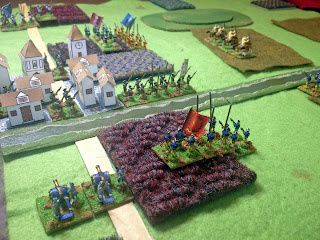This is one of my favourite scenarios in the One Hour Wargames book. I've played it several times and it always gives an exciting and close game. One force is defending a strategic river crossing at a town. Their opponents are advancing to cross but, unknown to the defenders, there is a ford further down the river of which they were unaware. The objective is a hill in the attacker's rear area; the defenders must rush to defend the hill as the attackers cross the river at a point which is not covered.
Once again I used my Great Northern War Swedes and Russians. And, once again, the Swedes were the attackers. They had four infantry regiments, some cavalry and some artillery.
The defending Russians also had four infantry regiments, as well as one each of dragoons and cavalry.
Here's the battlefield. The Russians had to set up in or close to the town, and the Swedes on the side of the river at the bottom of the picture. The Russians put most of their troops in a position to take the hill or contest the ford which the swedes were already approaching. However some Swedes were covering the town, so the dragoons were put into it as a defensive measure, and another infantry regiment deployed in support. A final infantry regiment was deployed as a reserve.
The Swedes covered the town with one infantry regiment and the artillery.
Their cavalry and two infantry regiments rushed towards the ford.
They crossed, and were engaged by the Russian cavalry.
Meanwhile Russian infantry moved to occupy the hill.
The fighting before the town was intense, with both sides taking heavy casualties. However a scenario specific rule which prevented the Swedes from firing on their first turn left them at a slight disadvantage in the firefight.
As the cavalry duel continued on the Swedish right, both sides formed into lines for the inevitable battle for the hill.
A Swedish regiment broke before the town. But they had committed their reserve to take its place.
The Swedish cavalry also broke.
The Russians supporting the town now fled.
As did their cavalry, under fire from the Swedish main line. Both sides had lost a couple of units.
The two infantry lines exchanged musketry.
Leaving the artillery to bombard the town, the Swedes switched their reserve regiment to the centre, where it could use long-range fire to support the attack on the hill.
Another Swedish regiment broke.
Then a Russian regiment. However the Swedes now only had one unit on the Russian side of the river, and the Russians still had two, one completely fresh.
The Swedish reserve regiment rushed to cross the ford and support the other unit directly.
The Russians sent a damaged regiment to oppose and delay the crossing, leaving their fresh reserve unit to hold the hill.
The Swedes formed up at the ford ...
... then surged across, breaking the defending Russian regiment in their first attack.
The dragoons fell back from the town and reformed. I don't have any specific dragoon figures, so for these games I use cavalry and infantry mixed together. Two infantry stands and a cavalry stand denote dismounted dragoons and two cavalry stands and an infantry stand denote mounted.
The defenders on the hill took heavy casualties from the Swedish attack.
Another Swedish regiment broke, but their reserve was moving up.
Another attack on the hill ...
... supported by artillery ...
... and the Russians broke.
Only the dragoons could save the day for the Russians. They mounted up and rushed towards the hill.
With no time to dismount, they charged the Swedish infantry, but the infantry pikes and their hilltop position blunted the attack.
The dragoons withdrew.
The game was now into its last turn. The dragoons dismounted and, although they were still fighting at nightfall, their musketry was insufficient to dislodge the Swedes from the objective.
So, another victory for the Swedes, although a close one. Early in the game it looked like their attack had no steam and that the Russian defences were too strong. But a timely committal of the reserve unit in the right paces at the right times swung the battle in their favour. The Russian defence was good, although the dragoons could have probably withdrawn from the town a turn or so earlier. It's easy in this scenario to regard the town as an objective when really it's just a means for defending one of the river crossings. The main reason for the defenders holding it is to prevent them having to fight in two places. And once the Swedes were only attacking it with artillery there was little point in insisting on holding it.
Again the rules held up well, although I am beginning to think that the advantage the Swedes get in their ability to move and fire at full effect at close range does give them an edge which is not entirely offset by their weakness at longer ranges. However I need to play more games in order to see if this is true and to decide on how to fix it if it is. After all, we can't have the Swedes winning
every battle.
Follow the rest of the scenario refights HERE






























































